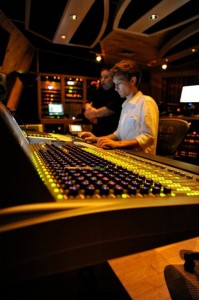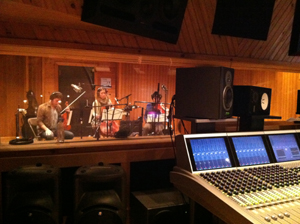Psyched On Sonics: How to Record Strings
Matt McCorkle of EqualSonics.com offers a case study on recording violin, viola and cello.
 The Mission: A String Tracking Session At Tainted Blue Studio NYC
The Mission: A String Tracking Session At Tainted Blue Studio NYC
Producer Andrew Koss, owner of Tainted Blue Studio, recently requested my services tracking string overdubs for Maxine Linehan‘s version of the Leslie Gore hit “You Don’t Own Me” for her new album release, dropping near the end of this year. The session called for overdubbing a string trio on to pre-existing tracks.
Tainted Blue Studio is an amazing facility for tracking strings, with its all wood live room and tasty microphone collection. It’s a playground for engineers, producers and musicians alike.
The Challenge
String recording can be a tricky and challenging process. The goal is to capture the instruments in their purest form, highlighting each instrument’s sonic range while avoiding the masking of individual instruments. To ensure that the players sound good in the room together, you can “acoustically mix” just by moving a couple of chairs and players around in the physical room.
Patience and listening to various microphone placements are key to a good recording. If you’re unsure about how your microphone placement will sound, listen to it! Poor string recordings come from microphone phase cancellation at certain frequencies and ugly reflections from various surfaces. I enjoy the challenge string recordings bring, as the approach for this type of recording is much different than any other instrument.
The Arrival
Once at the studio, I began examining the tracks in Pro Tools listening for how to blend these string overdubs together. Then I approached the producer, Andrew Koss, inquiring into the type of sound he was looking to capture with today’s string tracking. “Intimate and warm,” was the answer.
My plan was to mike the instruments individually, to get the warmth. To get the intimacy, I planned to use an XY stereo configuration to capture the instruments playing together in their natural environment of the live room.
The Quest for Intimacy
First, I positioned three seats equally apart from one another, in a semi-circle facing the glass in the live room. Next, I picked two AKG 414’s to be used in my XY stereo configuration. Also, I wanted to make sure that the cellist will be in the center of my XY stereo configuration, as to not throw off either side of the stereo spectrum later on in the mix.
Then I proceeded to make the angle at which the microphone capsules will be positioned to form the XY configuration. My focus here was to make sure that both the violin and the viola would be in the pickup zone of their respective 414, which were both set in cardioid polar pattern. My goal with the XY setup is to have the violin to the left, the cello in the center, and the viola to the right in the stereo spectrum.
Intimacy obtained!
The Quest for Warmth
Warmth! The second half of the producer’s request. This called for getting up close and personal with each instrument. I began with the cello, and chose a Royer 122 for this task, a phantom-powered ribbon microphone.
It’s strange because when I was first learning audio the golden rule was “Never apply phantom power to ribbon microphones!” This is because applying 48 volts to a ribbon microphone will normally blow up the ribbon element. But, what am I doing today? Applying phantom power to ribbon microphones!
There are exceptions to rules and the Royer 122 is one of those exceptions. This ribbon microphone has an amazing tone and accepts phantom power to enable a much higher output gain.
I listened to the cellist play her instrument for a few minutes. After listening carefully to the way this particular cello acts and responds to her bowing, I grabbed my mic and went to work.
I positioned the Royer just above the bridge of the cello pointing near the body and the F Hole. This was to capture the bowing of the strings and body of the cello. However, I had a problem with this microphone placement – not enough low end was going to be captured. I remedied this with a large capsule dynamic Audix D6 microphone. (What a mouthful!) I directed this microphone towards the body of the cello pointed around the F Hole. These two microphones together will produce a full-bodied cello while capturing the players’ nuances.
Next up for treatment, the viola. This instrument sits between the cello and the violin in the sonic spectrum. Listening for a microphone placement, too close to the body will produce too much low end that will compete with the cello for sonic space. Too far away from the body will make the instrument sound thin. The viola can be a tricky placement as you want to make sure it doesn’t compete with either the cello or the violin.
I choose a Royer 122 for this instrument as well. I had the violist play some of the chorus for me as I leaned over the instrument to have a listen, and sure enough found my spot for the microphone placement! I positioned the microphone over the viola about 15 inches, encompassing the instrument in the microphones entire pickup pattern. The Royer 122 is a slim, elongated microphone so I was able to position it parallel with the viola to get a warm, natural sound. Along the way, I was primarily focused on picking up the strings and body of this instrument.
Finally… the violin. I took the same approach with the violin that I had with the viola. However, I opted for a switch in microphones, choosing to go with a Neumann U87. I like the voicing of this microphone as it tends to be nice and pleasant on the violin, bringing its high-mid frequency nuances to life. This microphone choice also helps out the stereo panorama later in the mix, as it will provide a different texture from the Royers when the close mics are mixed together with the 414’s in their XY stereo configuration.
Hear “You Don’t Own Me” and witness the behind the scenes video (complete with string session footage) right here:
Did You Double Check?
After wrapping up my microphone placements, I made sure that all my stands were tight, the cables were looking neat and secure, and the artists were comfortable. My assistant, Michael Thurber, was finished getting every artist their own cue mixer and cans – this was so each player could personalize their own cue mixes while tracking. With one quick glance around the live room to make sure all was well, we headed to the control room.
What do You Know of Signal Flow?
In the control room I went to the patchbay to start my signal flow. First up to get piped through some TT cables were the 414’s into an Avalon 2022, a stereo pre-amp. These two play very nice together, as they produce a nice smooth top end that is very appealing for strings. The 414’s as drum overheads coupled with the Avalon 2022 is simply amazing as well!
The two Royer 122s and the Neumann U87 were sent through a Grace 801 unit – I was very confident in my microphone placement and was not looking for much coloration on the pre-amp side of my signal flow.
Lastly, I patched up the Audix D6 through a vintage Neve 1073 pre-amp to pump it full of low-mid silkiness to give the cello a smooth and rich body. After my pre-amp patching I patched the line level signals straight into the studio’s Apogee converters, which are directly linked to Pro Tools HD. We were ready to set pre-amp gain levels!
How Healthy Are Your Levels?
I kindly asked each player to give me a range of expressions on their instrument, adjusting the close microphone pre-amp’s gain accordingly. After I was satisfied with my close microphones’ pre-amp levels, I had them play together as a trio. I then set the gain levels on the Avalon 2022 for the 414’s XY stereo configuration.
With the pre-amp gain levels set, I panned my channels corresponding to the string players’ placement in the live room and then made some quick monitoring level adjustments.
Time to begin tracking!
The Moment You’ve Been Waiting For!
The producer, who also created this amazing string arrangement, started speaking with the musicians prepping them for various parts in the song.
We took a pass from start to finish. After some kinks were worked out and the musicians felt comfortable, we started taking full passes at the song, layering. Layered a few passes of the string section on top of each other to get a nice, full sound. After the initial layering we went on to add accent tracks of various expressions throughout the track, with the trio still playing together.
The producer had some final parts for each instrument to add depth and nuance to the string section. To accomplish this we had each player take individual passes in various parts of the song. (This was the only time each instrument was playing solo.)
Tracking complete!
The Final Touches
My assistant went to begin breaking down the live room, waiting for the capacitors in the condenser microphones to dissipate their 48 volts. If one were to disconnect the microphone cable immediately after turning off phantom power, damage could occur to the condenser microphone. This is extremely important, and forgetting this is a sure way to get fired on your first assisting gig! Wait a few minutes, to be safe, if you are not sure of how long your particular condenser microphone takes to discharge its capacitors.
While the live room breakdown was being completed, I began to listen back to the recorded tracks in order to start making a quick, rough mix. Then printed the rough mix, labeled our session, backed up our file and gathered our notes.
The arrangement was beautiful and the string tracks came out wonderfully. For the main, accent and individual passes the mixer will have plenty of choices on which microphone tracks to use. They could use the XY stereo configuration, just the close microphones, or a mixture of both depending on what sound they are trying to achieve at that particular moment in the mix.
It was a successful tracking session at Tainted Blue Studio. It’s always a pleasure to track great musicians, in a great room, with great a big selection of audio toys.
As the owner and operator of his own mobile recording studio, Matt McCorkle of EqualSonics.com is capable of bringing professional audio to anyone, anywhere, anytime. His expertise involves acoustic instrumental recordings, vocal productions, live tracking sessions, electronic music production and mixing. Whether in the studio or out in the field, Matt’s goal is simple: To create new music and sounds with passionate artists. To contact Matt please visit EqualSonics.com.







